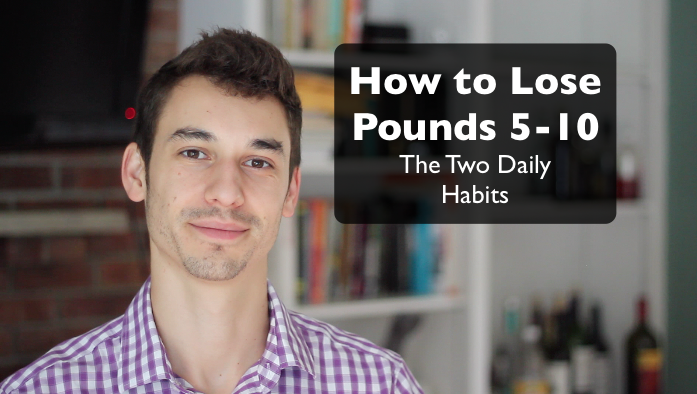
How To Lose Pounds 5 – 10: The Three Daily Habits (The 20 Pound Roadmap Series)

Earlier this week, I talked about how exactly to lose your first 5 pounds, which are often the easiest from a weight loss perspective, but the hardest from an overall perspective – because of the presence of bad habits, the lack of momentum and motivation, and the overall confusion and overwhelm that can result.
We talked about:
- Looking at your “why” twice daily to hold yourself accountable
- One key nutritional principle to apply to each and every meal
In case you missed pounds 0-5 in the series, go back and watch it here.
Let’s get started with phase 2: losing pounds 5-10.
Why The Next 5 Pounds Are Different to Lose
Think about it:
When did you last want to make a HUGE life change?
Whether it was get a new job, move to a new place, embark on a new quest to improve your health, or just start something new – the beginning is tough right?
You’re confused, wondering what to focus on.
You’re overwhelmed, not knowing what’s going to produce the most results for the least amount of time invested.
But once you get started, things are different, right?
Your mindset improves: Thinking this was once impossible, you start to see the horizon. Things start coming together. Your mood improves, you feel more motivated, things begin to “click” and slowly but surely things begin to fall into place.
It starts to just make sense.
In fact, once this “horizon” shows, this is a HUGE sign – not only that you’ve begun to make some progress, but also that you’re overcoming some of the “internal narrative” going on in your head. The demon little voice that tells you “you can’t” begins to shut up.
The next thing is that you now have momentum.
You know that old demon the resistance? That stuff preventing you from getting from where you are, to where you want to be?
Once you have momentum, the voice begins to get quieter. And the voice that inspires you begins to get stronger.
It’s just like anything; once you start a new habit, it can be a bit rough or feel like it takes massive willpower, effort and discipline. However, once you just start, it’s so much easier.
Ever start a new hobby, or go to a meetup group and you’re really nervous and don’t want to go in the door, but once you show up, you leave having had the best time of your life?
That’s just the psychological resistance to something new. Like anything, it will pass.
Once you get into phase 2, the mind is quiet and you’ve begun to gain some momentum.
 The third aspect is habit development.
The third aspect is habit development.
For those of you who successfully started exercising, after formerly hating it, you know what I’m talking about.
(FYI if you hate exercise, here’s how to psychologically trick yourself into exercising).
Sometimes, even when we know we’re just going for a 5 minute walk, we really don’t want to.
It’s not a long walk.
But it’s also not a hard walk.
What gives?
Why don’t I want to do this?
Sometimes it’s this weird feeling of nonspecific resistance. Not wanting to do it, but not having a good reason to do it. But after a couple of weeks, we’ve acquired the habit, we know it’s only frustrating at the beginning, and 30 seconds after we begin, we’re in a good mood which often sticks around for hours afterwards.
Your Next Three Accelerator Habits
So let’s talk about three new, core nutritional habits for the next 5 pounds lost.
- Swap your carbs (Don’t remove them)
- The liquid calorie MF principle
- The +1 blueprint
1. Swap Your Carbs
Alrighty… one of the easiest big wins for your health (especially if you don’t know where to begin) is this: rather than removing carbs, swap them.
A while back I talked about a Yale professor that was chartered to figure out what diets “actually worked” among all the popular diets out there.
He didn’t come to any conclusions except one: focusing on real food, and not removing food groups, seemed to work best. Rather than avoiding carbs, the successful people changed which carbs they ate. In case you forgot this video, read more on it here.
So let’s talk about exactly what that means.

Click here to make the image larger.
The Glycemic Index is a way of measuring how food affects your blood sugar. Foods high in the glycemic index scale spike your blood sugar in large amounts after consuming them.
Why is this important?
High GI foods have repeatedly been linked to obesity, disease, and other health complications, while low GI foods have been linked to overall better health.
This really isn’t surprising, since most of the foods listed on the High GI list there are white bread, breakfast cereals, sugar, bagels, etc., and the foods on the Low GI scale are vegetables, fruits, and so on.
So, your first tiny habit here is to swap out any high GI carbs, for low GI carbs.
So take all those:
- White breads
- White rice
- Breakfast cereals
- Sugar
- Pretzels
- Any other product of white flour
And replace it with:
- Beans
- Seeds
- Most sweet fruits
- Most vegetables
- Whole grains like millet, oat, rye, rice, etc.
Easy to do, easy not to do! You can still eat all your favorite carbs, just change which you eat.
2. The M-F Liquids rule
By far, I think the easiest way for a person to lose a few pounds (or even 10 or 20 depending on the individual) is to just remove or scale down liquid calories.
Consider the daily routine of the average American:
- Morning orange juice (120 calories)
- Starbucks frappucino (Minimum 200 calories, sometimes more)
- An afternoon Coke or soda (150 calories)
That’s almost an extra 500 calories per day of stuff, that quite honestly, doesn’t add that much nutrition to your life – just a lot of sugar calories. Even the orange juice isn’t great compared to eating oranges themselves.
So here’s your simple habit to start cultivating:
Put a ban on the liquid calories Monday – Friday.
If you’re following a routine similar to the typical American, that alone is 2500 fewer calories every 5 days. Even binge eating (or rather, drinking) on the weekends is totally fine – but try it only Saturday and Sunday.
This brings us to the third habit: the +1 blueprint.
3. The +1 Blueprint.
New year’s resolutions suck and usually fail. But that’s okay – if you’re a reader here, you already know that setting new year’s resolutions goes against the “there is no perfect time to start” principle.
If something has to change, change it today – not next year.
In any case, this +1 blueprint is a really simple principle you can follow to make new habits that actually stick around.
A couple years ago, after I moved back from China, my buddy and I decided we wanted to take our meditation to the next level.
We wanted to meditate more than an hour per day, every single day, but we wanted to do it in a small, measurable, baby steps way.
So here’s what we did: we started with just 1 minute. And then we added 1 minute per day.
That’s it.
So even after 15 days of doing this, it was only 15 minutes of meditation. Easy to do. Easy not to do. But after more than three months, we were doing 100 minutes per day of meditation, which is a LOT for the average person. And we both made quantum leaps in our personal development.
It also made me realize this: VERY few people ever take the time to truly take the baby steps approach to habits. Almost no one starts with just a few minutes of exercise, and then adds one minute per day.
It’s human nature. We’re impatient.
But I want you to take ONE of your tiny habits, a new health habit you want to ingrain, and then just add +1 per day.
Whatever it is:
- Cook one more meal per day
- Walk one more minute each day
- Do one more repetition of an exercise
- Do yoga one minute longer
- Go to bed 1 minute earlier
- Drink one more glass of water
Super easy, and life transforming if you actually do it.
So, for phase two, here are the three habits:
- Swap your carbs
- Follow the M-F liquids principle
- Do the +1 habit blueprint
Get started, and make things happen.
– Alex

I want to thank you for this “real” approach to losing weight and getting my life cackle. I have many health challenges right now but with a realistic approach I feel this will become possible!
Thank you?
Sue